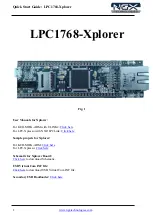
Positive
Brushes
7-
The
positive
brush
or
brushes
can
always be identified
as the brushes connect-
ed to the field coil.
Obtain
an ohmmeter.
Connect
one lead
of the meter to the end of the brush and the
other
lead to the terminal.
The ohmmeter
MUST
indicate
continuity
between
the
brush and the terminal.
If the meter
indi-
cates
any resistance,
check the lead to the
brush and the lead to the positive
terminal
solder connection.
If the connection
cannot
be repaired,
the brushes
MUST
be replaced.
If the unit being tested
has a double set of
positive
brushes,
repeat
the
test
for
the
other positive brush.
Move the test
lead from the brush to a
good ground on the frame.
If continuity
is
indicated,
the
field coil is grounded
to the
case.
Negative
Brushes
8-
The negative
brushes
can always
be
identified
because
the lead is connected
to
the brush retainer
as a ground to the frame.
Obtain an ohmmeter.
Make contact
with
one lead
on the
negative
brush and make
contact
with the
other
lead on the starter
frame.
If
the
meter
does
not
indicate
continuity,
the brush or brush retainer
is not
grounded to the frame.
If the unit being tested
has a double set
of negative
and positive
brushes,
move the
test
lead from the one negative
brush to the
other
negative
brush lead and again
check
for continuity.
If the meter
does not indi-
cate
continuity,
the brush or brush retainer
is not grounded to the frame.
Check
to be sure
none of the
soldered
connections
are
touching
the
frame.
The
DELCO-REMY STARTER
6-31
fields would be grounded if the connections
make contact
with the frame.
CLEANING
AND
INSPECTING
Clean the field coils, armature,
commu-
tator,
armature
shaft,
brush-end
plate
and
drive-end
housing with a brush or compress-
ed air.
Wash all other
parts
in solvent
and
blow them dry with compressed
air.
Inspect the insulation
and the unsoldered
connections
of
the
armature
windings
for
breaks or burns.
Perform
electrical
tests
on any suspect-
ed defective
part,
according
to
the
pro-
cedures outlined earlier
in this Section.
Check the commutator
for run-out.
In-
spect
the armature
shaft
and both bearings
for scoring.
Typical
brush spring.
If
the springs
have
turned blue
in
color, they must
be
replaced.
Summary of Contents for 4906B 4HP 1969
Page 5: ......
Page 87: ...3 46 POWERHEAD Exploded drawing of a 7 5 hp powerhead 1956 58 with principle parts identified...
Page 88: ...CYLINDER BLOCK 3 47 HEAD GASKET RING...
Page 90: ...CYLINDER BLOCK 3 49 THERMOSTAT EXHAUST COVER The...
Page 137: ...4 46 FUEL LEVER AND LOW SPEED...
Page 153: ...4 62 FUEL Exploded view of a pressure tyoe fuel tank with major parts identified...
Page 157: ...4 66 fUEL...
Page 412: ...A 16 APPENDIX Wire Identification 33 hp with Generator 1965 67...
Page 413: ...APPENDIX A 17 o C...
Page 414: ...Wire Identification 33 hp with Generator 1969 70...
Page 415: ...APPENDIX A 19 Wire Identification 35 hp 1957 59...
Page 416: ...A 20 APPENDIX Wire Identification 40 hp Standard Shift with Generator 1960 66...
Page 417: ...APPENDIX A 21 UJ cc b Wire Identification 40 hp Standard Shift with Generator 1967 68...
Page 419: ...APPENDIX Wire Identification 40 hp Electric Shift with Generator 1961 66 A 23...
Page 420: ...A 24 APPENDIX C 00 Wire Identification 40 hp Electric Shift with Generator 1967 68...
Page 421: ...Wire Identification 40 hp Electric Shift with Generator 1969 70...
Page 422: ...NOTES NUMBERS...













































